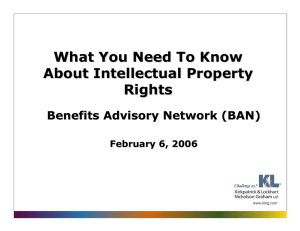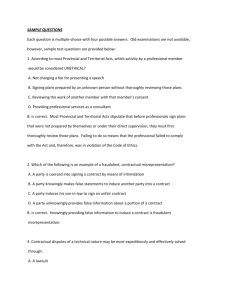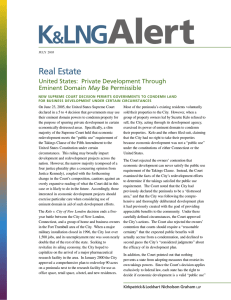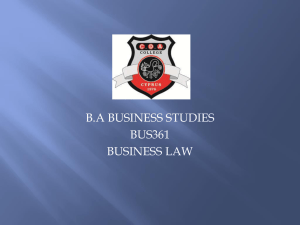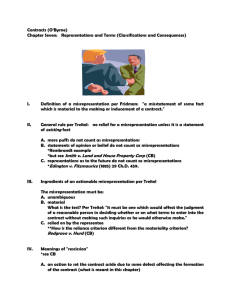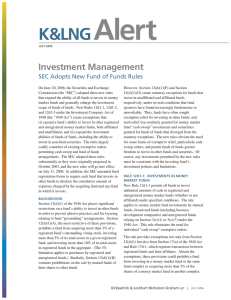Construction Law
advertisement
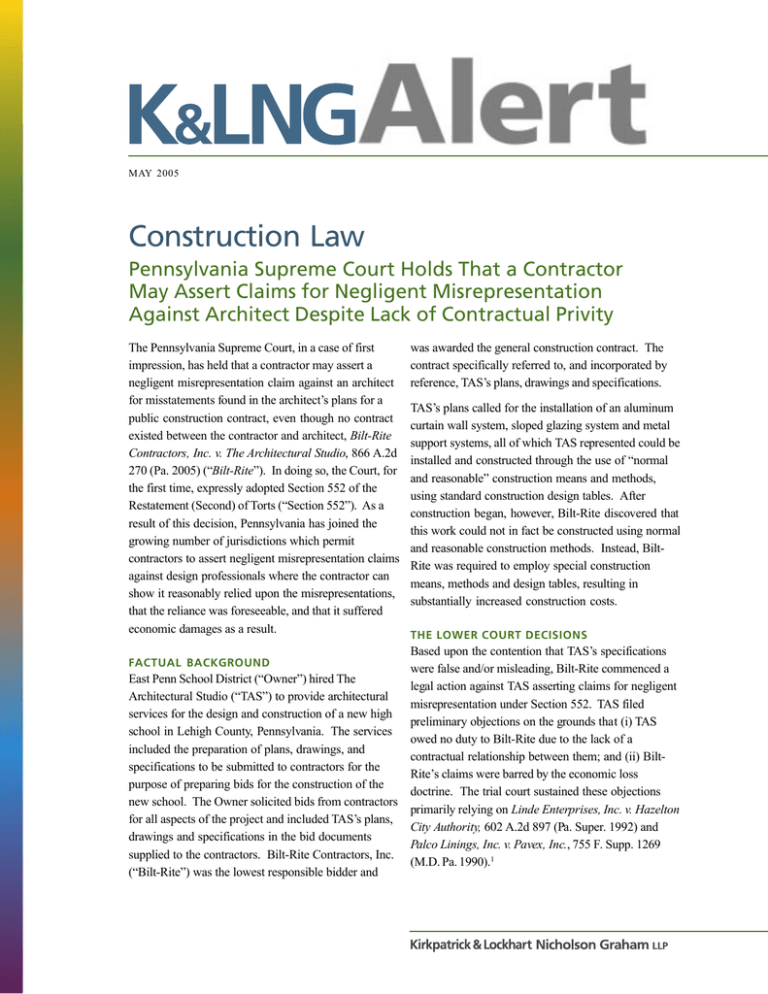
MAY 2005 Construction Law Pennsylvania Supreme Court Holds That a Contractor May Assert Claims for Negligent Misrepresentation Against Architect Despite Lack of Contractual Privity The Pennsylvania Supreme Court, in a case of first impression, has held that a contractor may assert a negligent misrepresentation claim against an architect for misstatements found in the architect’s plans for a public construction contract, even though no contract existed between the contractor and architect, Bilt-Rite Contractors, Inc. v. The Architectural Studio, 866 A.2d 270 (Pa. 2005) (“Bilt-Rite”). In doing so, the Court, for the first time, expressly adopted Section 552 of the Restatement (Second) of Torts (“Section 552”). As a result of this decision, Pennsylvania has joined the growing number of jurisdictions which permit contractors to assert negligent misrepresentation claims against design professionals where the contractor can show it reasonably relied upon the misrepresentations, that the reliance was foreseeable, and that it suffered economic damages as a result. was awarded the general construction contract. The contract specifically referred to, and incorporated by reference, TAS’s plans, drawings and specifications. TAS’s plans called for the installation of an aluminum curtain wall system, sloped glazing system and metal support systems, all of which TAS represented could be installed and constructed through the use of “normal and reasonable” construction means and methods, using standard construction design tables. After construction began, however, Bilt-Rite discovered that this work could not in fact be constructed using normal and reasonable construction methods. Instead, BiltRite was required to employ special construction means, methods and design tables, resulting in substantially increased construction costs. THE LOWER COURT DECISIONS Based upon the contention that TAS’s specifications were false and/or misleading, Bilt-Rite commenced a East Penn School District (“Owner”) hired The legal action against TAS asserting claims for negligent Architectural Studio (“TAS”) to provide architectural misrepresentation under Section 552. TAS filed services for the design and construction of a new high preliminary objections on the grounds that (i) TAS school in Lehigh County, Pennsylvania. The services owed no duty to Bilt-Rite due to the lack of a included the preparation of plans, drawings, and contractual relationship between them; and (ii) Biltspecifications to be submitted to contractors for the Rite’s claims were barred by the economic loss purpose of preparing bids for the construction of the doctrine. The trial court sustained these objections new school. The Owner solicited bids from contractors primarily relying on Linde Enterprises, Inc. v. Hazelton for all aspects of the project and included TAS’s plans, City Authority, 602 A.2d 897 (Pa. Super. 1992) and drawings and specifications in the bid documents Palco Linings, Inc. v. Pavex, Inc., 755 F. Supp. 1269 supplied to the contractors. Bilt-Rite Contractors, Inc. (M.D. Pa. 1990).1 (“Bilt-Rite”) was the lowest responsible bidder and FACTUAL BACKGROUND The trial court considered itself bound by the Superior Court’s decision in Linde which held that “a contractor cannot prevail against an architect for economic damages suffered as a result of negligence in drafting specifications, absent privity of contract between the contractor and the architect.”2 The trial court found further support in the Palco court’s discussion of two possible exceptions to the economic loss doctrine: (1) where there is an intentional misrepresentation and (2) in the context of negligent misrepresentations, where the defendant is in the business of supplying information that is relied upon by others.3 The trial court noted that Palco held that neither exception applied to architects.4 The Superior Court, in an unpublished decision, affirmed the trial court’s decision. In considering the issues before it, the Superior Court noted that absence of privity was not an absolute bar to economic damages in a tort setting.5 Instead, the court stated that relationships exempt from the privity requirements must be decided on a case-by-case basis.6 The court noted that although the Pennsylvania Supreme Court had cited to Section 552 with approval, it had never been expressly adopted.7 Moreover, Section 552 had never expressly included or excluded the architect-contractor relationship.8 Citing its decision in Linde for authority, the Superior Court held that the architect-contractor relationship was not exempt from the privity requirements.9 Subsequently, Bilt-Rite appealed the Superior Court’s decision to the Pennsylvania Supreme Court. distinguished on factual grounds three recent Supreme Court decisions addressing the tort of negligent misrepresentation and Section 552. The first of these three decisions was in Bortz v. Noon, 729 A.2d 555 (Pa.1999), wherein the Court concluded that no special relationship existed between a real estate agent and a buyer, and thus no duty was found on behalf of the agent.11 Next, the Court considered Gibbs v. Ernst, 647 A.2d 882 (Pa. 1994), which discussed negligent misrepresentation in the context of adoption. Although it cited to Section 552 with approval, the Court also noted in Gibbs that Pennsylvania had long recognized the common law tort of negligent misrepresentation.12 Ultimately, the Court in Gibbs found that the parents had stated a viable claim for negligent misrepresentation against the adoption agency.13 Finally, the Court reviewed its decision in Rempel v. Nationwide Ins. Co., 370 A.2D 366 (Pa. 1977), which again cited with approval to Section 552, but did not expressly adopt it.14 After discussing its treatment of Section 552, the Court went on to review its recent decision in Sharpe v. St. Luke’s Hospital, 821 A.2d 1215 (Pa. 2003) for a discussion of general principles of negligence. In Sharpe, the Court held that a hospital that had conducted drug testing of a third party’s employee could be liable to the employee even though there was no privity of contract.15 The Court cited to five factors to determine whether a duty in tort existed: 1) the relationship between the parties; 2) the social utility of the actor’s conduct; PENNSYLVANIA SUPREME COURT PERMITS NEGLIGENT MISREPRESENTATION CLAIMS AGAINST ARCHITECT On appeal, the Pennsylvania Supreme Court reversed the trial court’s dismissal of the contractor’s negligent misrepresentation claims. The Court began its analysis by first recognizing that the question of whether a contractor may assert negligent misrepresentation claims against a design professional under Section 552 was one of first impression under Pennsylvania law.10 In so stating, the Court 2 MAY 2005 3) the nature of the risk imposed and forseeability of the harm incurred; 4) the consequences of imposing a duty upon the actor; and 5) the overall public interest in the proposed solution.16 Based on these factors, the Court in Sharpe held that a “tort duty can arise absent privity of contract” between the employee and the hospital conducting the testing.17 KIRKPATRICK & LOCKHART NICHOLSON GRAHAM LLP With the above-referenced precedent as a guide, the Court then went on to examine the application of the Linde and Palco decisions that were relied upon by the lower courts. The Court noted that the panel in Linde had rejected the claim largely because Pennsylvania law had not yet accepted the cause of action.18 The Court then commented on the Palco court’s reliance on Illinois case law.19 Further, the Court noted that as the highest court in Pennsylvania, it was not bound by the decisions in Linde and Palco.20 In short, the Court declined to follow those decisions. Instead, the Court looked to decisions from other jurisdictions which have allowed contractors to assert negligent misrepresentation claims against design professionals. In particular, the Court discussed at length decisions from Massachusetts21 and Arizona,22 and also noted concurring opinions from Georgia,23 Montana,24 North Carolina,25 South Carolina26 and Tennessee.27 Based primarily upon the rationale set forth in the decisions from other jurisdictions, the Court concluded as follows: We are persuaded by these decisions from our sister jurisdictions that (1) this Court should formally adopt Section 552 of the Restatement (Second), which we have cited with approval in the past, as applied by those jurisdictions in the architect/contractor scenario; (2) there is no requirement of privity in order to recover under Section 552; and (3) the economic loss rule does not bar recovery in such a case. Recognizing such a cause of action, with such contours, is consistent with Pennsylvania’s traditional common law formulation of the tort of negligent misrepresentation.28 Although the Court made clear that Section 552 would be applicable to architects and design professionals, it clarified that their liability would not be limitless in that only those “for whose benefit and guidance the information is supplied” may assert such claims. 29 Therefore, liability is limited to those whose use of the information is “reasonably foreseeable” to the design professional.30 In addition, the Court noted that by adopting Section 552, it was not supplanting the common law version of the tort; 3 MAY 2005 instead, Section 552 is intended to clarify the elements of the tort as it is applied to businesses engaged in the supply of information.31 In finding that an architect owes a duty in tort, the Court, relying on the Sharpe factors, noted that (1) although an architect or design professional may not have a contractual relationship with the contractor, the professional is well aware that the design will be provided to and utilized by others; (2) with respect to social utility of the conduct at issue, given the important reliance placed on professional services, there is no reason to exempt such professionals from the tort consequences of a negligent failure to perform those services in a competent fashion; (3) given the limitations found in Section 552, the tort adequately accounts for the nature of the risk the duty imposes and the forseeability of the prospective harm; (4) the consequence of imposing a duty upon design professionals is not unreasonable or unduly burdensome; and (5) Section 552 will serve the public interest by discouraging negligence among design professionals.32 In its second major holding, the Court rejected TAS’s contention that the economic loss doctrine barred Bilt-Rite’s claims. In so holding, the Court noted that “Pennsylvania has long recognized that purely economic losses are recoverable in a variety of tort actions including the professional malpractice actions.”33 The Court went on to note that “to apply the economic loss doctrine in the context of a Section 552 claim would be nonsensical: it would allow a party to pursue an action only to hold that, once the elements of the cause of action are shown, the party is unable to recover for its losses.” 34 Accordingly, the Court found that the economic loss doctrine is not a bar to recovery for claims of negligent misrepresentation under Section 552.35 The Court then applied its holdings with regard to Section 552 and the economic loss doctrine to the facts at hand. After noting that TAS provided plans and specifications for the school project with full knowledge that those plans and specifications would KIRKPATRICK & LOCKHART NICHOLSON GRAHAM LLP be included in a bid package supplied to prospective bidders and relied upon by those bidders, the Court held that the facts came within the framework of Section 552 such that Bilt-Rite had a cognizable claim against TAS under Pennsylvania law. 36 CONCLUSION The Bilt-Rite decision changes the contours of liability between design professionals and contractors on public projects in Pennsylvania. Despite the fact that no written contract may exist between them, a design professional may now be liable to contractors for errors in designs, plans and specifications which the design professional knew would be included in bid packages supplied to and relied upon by bidders. Bilt-Rite therefore “raises the stakes” for design professionals involved with public projects. Because the rationale employed by the Pennsylvania Supreme Court is equally applicable in the private contract setting, design professionals should expect the holding of Bilt-Rite will be made applicable to private projects as well. The Court, however, left open the question of whether a Certificate of Merit under Rule 1042.3 is required when bringing a claim of negligent misrepresentation against a design professional. As a result of the Bilt-Rite decision, design professionals need to be aware of these additional liabilities in (i) establishing and performing their scope of work; (ii) pricing their work; and (iii) procuring insurance products. In particular, design professionals should examine their existing professional liability policies and, if necessary, contact their carriers to make certain that their policies provide coverage for such liabilities to contractors. R.J. Chleboski rchleboski@klng.com 412.355.6372 Michael J. Zukowski mzukowski@klng.com 412.355.6397 ENDNOTES 19 1 20 Bilt-Rite, 866 A.2d at 273. 2 Id. 3 See id. 4 See id. at 274. 5 See id. 6 See id. 7 See id. 8 See id. 9 See id. 10 See id. The Court also noted that the question had split the lower federal courts in Pennsylvania and other state courts. Id. (citing Linde Enterprises, Inc. v. Hazelton City Authority, 602 A.2d 897 (Pa. Super. 1992), appeal denied, 617 A.2d 1275 (Pa. 1992) and Borough of Lansdowne v. Sevenson Env. Services, 2000 WL 1886578 (E.D. Pa. 2000)). 11 See id. at 278. 12 See id. at 279. 13 See id. 14 See id. 15 See id. at 283. 16 Id. at 281 (citations omitted). 17 Id. at 282. 18 See id. at 283. 4 MAY 2005 See id. See id. at 284. 21 Nota Construction Corp. v. Keyes Associates, 694 N.E.2d 401 (Mass. App. Ct. 1998). 22 Donnelly Construction Co. v. Oberg/Hunt/Gilleland, 677 P.2d 1292 (Ariz. 1984). 23 Robert & Company Associates v. Rhodes-Haverty Partnership, 300 S.E.2d 503 (Ga. 1983). 24 Jim’s Excavating Service, Inc. v. HKM Associates, 878 P.2d 248 (Mont. 1994). 25 Davidson and Jones, Inc. v. County of New Hanover, 225 S.E.2d 580 (N.C. Ct. App. 1979). 26 Tommy L. Griffin Plumbing & Heating Co. v. Jordan, Jones & Goulding, Inc., 463 S.E.2d 85 (S.C. 1995). 27 John Martin Co., Inc. v. Morse/Kiesel, Inc., 819 S.W.2d 428 (Tenn. 1991). 28 Bilt-Rite, 866 A.2d at 285. 29 Id. at 287. 30 Id. 31 See id. at 287. 32 See id. 33 Id. at 288. 34 Id. 35 See id. 36 See id. KIRKPATRICK & LOCKHART NICHOLSON GRAHAM LLP If you have any questions about this Alert or K&LNG, please contact the authors or one of the following members of our Construction Law practice: International Contact John R. Dingess 412.355.6564 jdingess@klng.com Boston Dallas Mark E. Haddad 617.261.3116 mhaddad@klng.com Paul E. Ridley 214.939.4905 pridley@klng.com Harrisburg Carleton O. Strouss Andrew L. Swope 717.231.4503 717.231.4512 cstrouss@klng.com aswope@klng.com London Kevin Greene James Hudson David Race 44.0.20.7360.8188 44.0.20.7360.8150 44.0.20.7360.8106 kgreene@klng.com jhudson@klng.com drace@klng.com Los Angeles Paul W. Sweeney, Jr. 310.552.5055 psweeney@kl.com Miami Robert B. Galt, III 305.539.3311 rgalt@klng.com Newark Anthony P. La Rocco 973.848.4014 alarocco@klng.com New York Michael R. Gordon 212.536.4855 mgordon@klng.com Pittsburgh George P. Foster Joseph L. Luciana, III. Richard F. Paciaroni 412.355.6709 412.355.8982 412.355.6767 gfoster@klng.com jluciana@klng.com rpaciaroni@klng.com San Francisco Jonathan M. Cohen Edward P. Sangster 415.249.1029 415.249.1028 jcohen@klng.com esangster@klng.com Washington David T. Case 202.778.9084 dcase@klng.com www w.. k l n g . c o m BOSTON ■ DALLAS ■ HARRISBURG ■ LONDON ■ LOS ANGELES ■ MIAMI NEWARK ■ ■ NEW YORK ■ PITTSBURGH ■ SAN FRANCISCO ■ WASHINGTON Kirkpatrick & Lockhart Nicholson Graham LLP (K&LNG) has approximately 950 lawyers and represents entrepreneurs, growth and middle market companies and leading FORTUNE 100 and FTSE 100 global corporations nationally and internationally. K&LNG is a combination of two limited liability partnerships, each named Kirkpatrick & Lockhart Nicholson Graham LLP, one qualified in Delaware, U.S.A. and practicing from offices in Boston, Dallas, Harrisburg, Los Angeles, Miami, Newark, New York, Pittsburgh, San Francisco and Washington and one incorporated in England practicing from the London office. This publication/newsletter is for informational purposes and does not contain or convey legal advice. The information herein should not be used or relied upon in regard to any particular facts or circumstances without first consulting a lawyer. Unless otherwise indicated, the lawyers are not certified by the Texas Board of Legal Specialization. Data Protection Act 1988 - We may contact you from time to time with information on Kirkpatrick & Lockhart Nicholson Graham LLP seminars and with our regular newsletters, which may be of interest to you. We will not provide your details to any third parties. Please e-mail cgregory@klng.com if you would prefer not to receive this information. © 2005 KIRKPATRICK & LOCKHART NICHOLSON GRAHAM LLP. ALL RIGHTS RESERVED.
